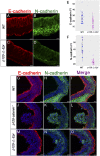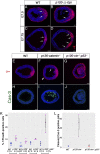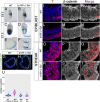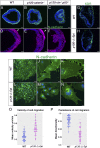p120-catenin regulates WNT signaling and EMT in the mouse embryo
- PMID: 31371508
- PMCID: PMC6708312
- DOI: 10.1073/pnas.1902843116
p120-catenin regulates WNT signaling and EMT in the mouse embryo
Abstract
Epithelial-to-mesenchymal transitions (EMTs) require a complete reorganization of cadherin-based cell-cell junctions. p120-catenin binds to the cytoplasmic juxtamembrane domain of classical cadherins and regulates their stability, suggesting that p120-catenin may play an important role in EMTs. Here, we describe the role of p120-catenin in mouse gastrulation, an EMT that can be imaged at cellular resolution and is accessible to genetic manipulation. Mouse embryos that lack all p120-catenin, or that lack p120-catenin in the embryo proper, survive to midgestation. However, mutants have specific defects in gastrulation, including a high rate of p53-dependent cell death, a bifurcation of the posterior axis, and defects in the migration of mesoderm; all are associated with abnormalities in the primitive streak, the site of the EMT. In embryonic day 7.5 (E7.5) mutants, the domain of expression of the streak marker Brachyury (T) expands more than 3-fold, from a narrow strip of posterior cells to encompass more than one-quarter of the embryo. After E7.5, the enlarged T+ domain splits in 2, separated by a mass of mesoderm cells. Brachyury is a direct target of canonical WNT signaling, and the domain of WNT response in p120-catenin mutant embryos, like the T domain, is first expanded, and then split, and high levels of nuclear β-catenin levels are present in the cells of the posterior embryo that are exposed to high levels of WNT ligand. The data suggest that p120-catenin stabilizes the membrane association of β-catenin, thereby preventing accumulation of nuclear β-catenin and excessive activation of the WNT pathway during EMT.
Keywords: WNT signaling; cell migration; epithelial–mesenchymal transition; gastrulation; p53-dependent cell death.
Conflict of interest statement
The authors declare no conflict of interest.
Figures






Similar articles
-
A positive role of cadherin in Wnt/β-catenin signalling during epithelial-mesenchymal transition.PLoS One. 2011;6(8):e23899. doi: 10.1371/journal.pone.0023899. Epub 2011 Aug 31. PLoS One. 2011. PMID: 21909376 Free PMC article.
-
Upon Wnt stimulation, Rac1 activation requires Rac1 and Vav2 binding to p120-catenin.J Cell Sci. 2012 Nov 15;125(Pt 22):5288-301. doi: 10.1242/jcs.101030. Epub 2012 Sep 3. J Cell Sci. 2012. PMID: 22946057 Free PMC article.
-
Brachyury cooperates with Wnt/β-catenin signalling to elicit primitive-streak-like behaviour in differentiating mouse embryonic stem cells.BMC Biol. 2014 Aug 13;12:63. doi: 10.1186/s12915-014-0063-7. BMC Biol. 2014. PMID: 25115237 Free PMC article.
-
p120-catenin in canonical Wnt signaling.Crit Rev Biochem Mol Biol. 2017 Jun;52(3):327-339. doi: 10.1080/10409238.2017.1295920. Epub 2017 Mar 3. Crit Rev Biochem Mol Biol. 2017. PMID: 28276699 Review.
-
Dancing in and out of the nucleus: p120(ctn) and the transcription factor Kaiso.Biochim Biophys Acta. 2007 Jan;1773(1):59-68. doi: 10.1016/j.bbamcr.2006.08.052. Epub 2006 Sep 7. Biochim Biophys Acta. 2007. PMID: 17050009 Review.
Cited by
-
Alternative splicing downstream of EMT enhances phenotypic plasticity and malignant behavior in colon cancer.Elife. 2022 Nov 8;11:e82006. doi: 10.7554/eLife.82006. Elife. 2022. PMID: 36346211 Free PMC article.
-
FABP4 mediates endoplasmic reticulum stress and autophagy to regulate endometrial epithelial cell function during early sheep gestation.J Reprod Dev. 2023 Dec 8;69(6):298-307. doi: 10.1262/jrd.2023-015. Epub 2023 Oct 2. J Reprod Dev. 2023. PMID: 37779094 Free PMC article.
-
A Tgfbr1/Snai1-dependent developmental module at the core of vertebrate axial elongation.Elife. 2020 Jun 29;9:e56615. doi: 10.7554/eLife.56615. Elife. 2020. PMID: 32597756 Free PMC article.
-
Functions of p120-catenin in physiology and diseases.Front Mol Biosci. 2024 Oct 21;11:1486576. doi: 10.3389/fmolb.2024.1486576. eCollection 2024. Front Mol Biosci. 2024. PMID: 39498333 Free PMC article. Review.
-
Loss of the Maternal Effect Gene Nlrp2 Alters the Transcriptome of Ovulated Mouse Oocytes and Impacts Expression of Histone Demethylase KDM1B.Reprod Sci. 2023 Sep;30(9):2780-2793. doi: 10.1007/s43032-023-01218-8. Epub 2023 Mar 28. Reprod Sci. 2023. PMID: 36976514 Free PMC article.
References
-
- Ishiyama N., et al. , Dynamic and static interactions between p120 catenin and E-cadherin regulate the stability of cell-cell adhesion. Cell 141, 117–128 (2010). - PubMed
Publication types
MeSH terms
Substances
Grants and funding
LinkOut - more resources
Full Text Sources
Other Literature Sources
Molecular Biology Databases
Research Materials
Miscellaneous

